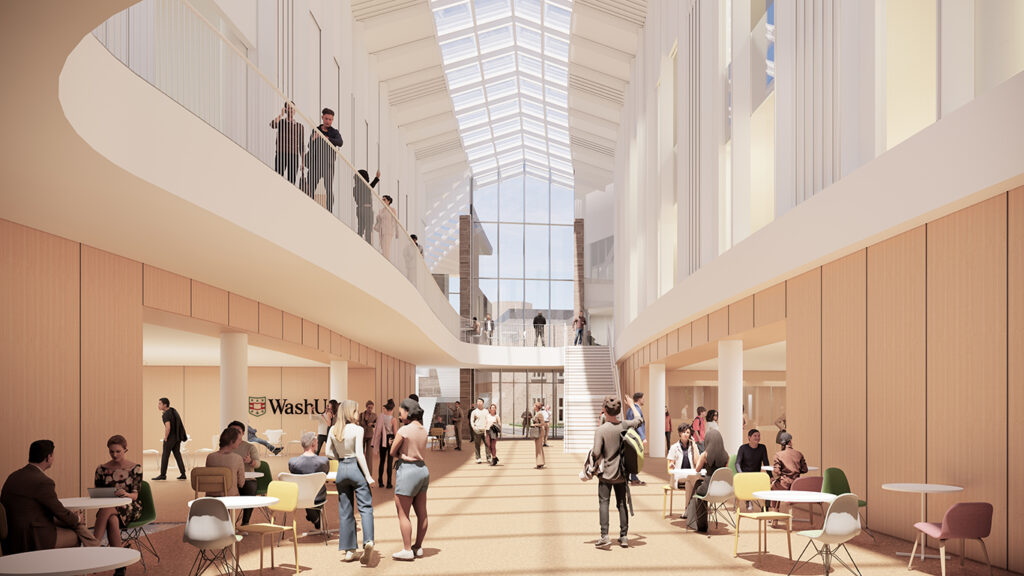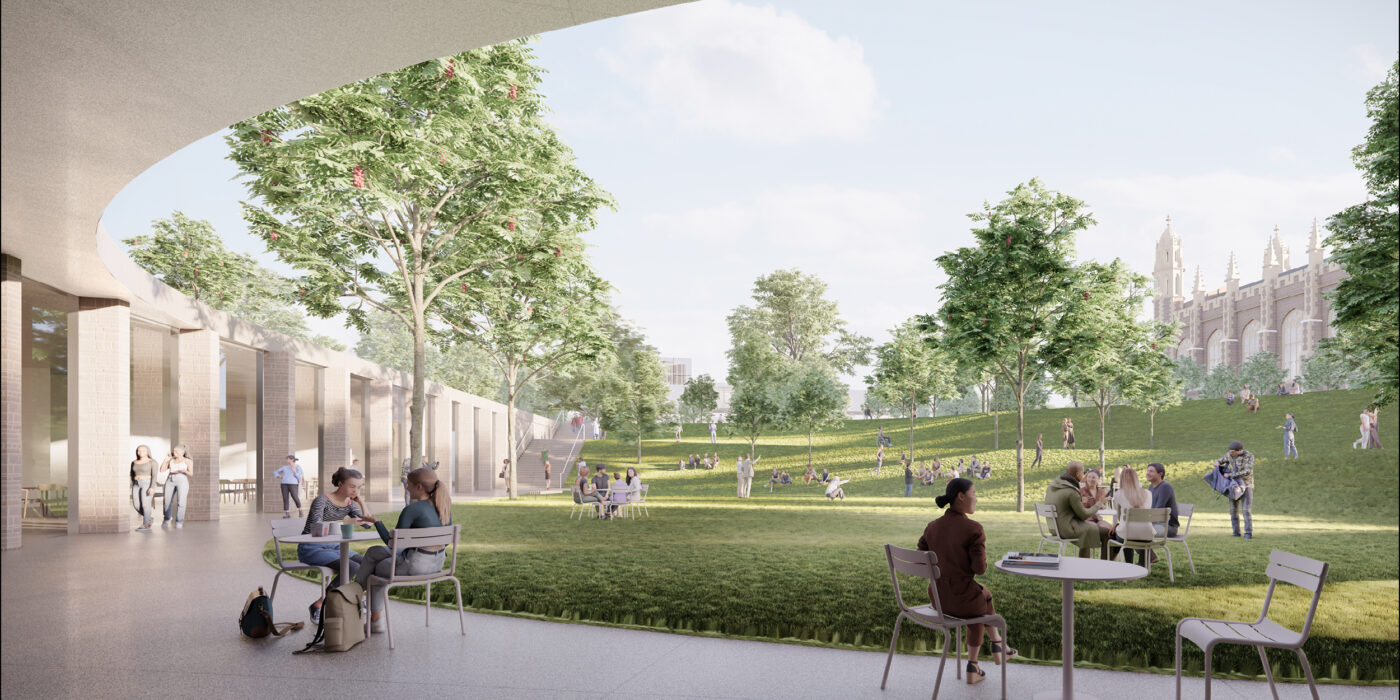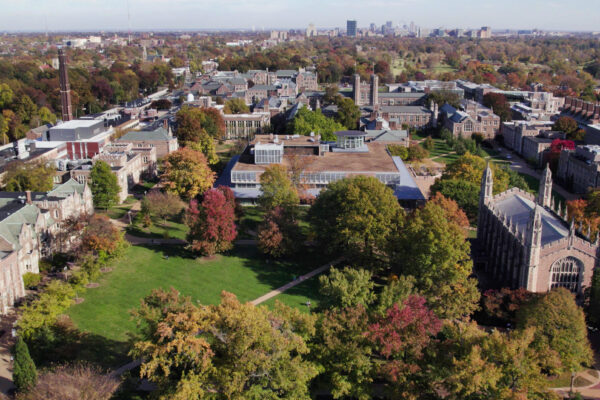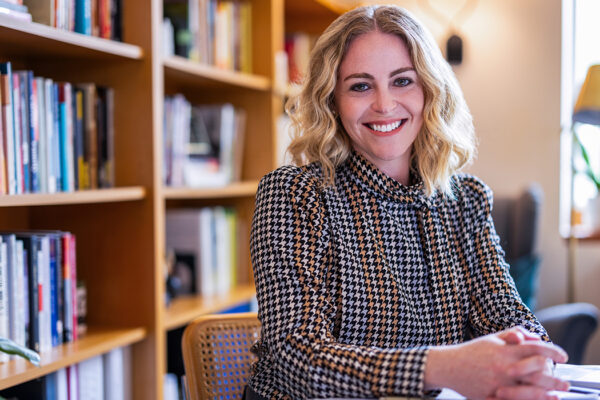A ceremonial groundbreaking for the first dedicated home for Arts & Sciences on the Danforth Campus took place Oct. 8 at Washington University in St. Louis.
The building will house some of the school’s premier departments and programs and serve as a cornerstone for scholarly and educational partnerships with other schools and units across campus.
The building, which will be west of Olin Library and northwest of Graham Chapel at the heart of the Danforth Campus, will be named Michael W. and Quirsis V. Riney Hall in recognition of a pledge from Michael, BSBA ’08, and Quirsis “Kaisy” Riney, St. Louis business leaders and philanthropists.
A new quad will be created between the building and the west side of Olin Library that will be called the Michael W. and Quirsis V. Riney Quadrangle.
Arts & Sciences, the largest school on the Danforth Campus, announced plans for the new building in December 2021 during the launch of its 10-year strategic plan.
While the school occupies roughly 40 buildings for Arts & Sciences departments, centers and programs, it does not have a dedicated home on the Danforth Campus.
Riney Hall will provide the school with that vital and recognizable space as it executes its ambitious strategic plan under the leadership of Feng Sheng Hu, the Richard G. Engelsmann Dean of Arts & Sciences.
“Riney Hall will be the crown jewel of Arts & Sciences, providing the school a state-of-the-art facility to house key departments and units, bring together student-facing academic services and resources, and create signature event and gathering spaces that will foster collaboration and the exchange of ideas for the entire WashU community,” said Hu, who is also the Lucille P. Markey Distinguished Professor.
“We’re grateful to Michael and Kaisy for their extraordinary support to help advance WashU’s liberal arts and sciences into a new era of interdisciplinary leadership,” said Chancellor Andrew D. Martin. “The finest modern universities have two things in common: strength in the liberal arts and a demonstrated commitment to interdisciplinary discovery and dissemination.
“Riney Hall will be more than a building,” Martin continued. “It will establish our future as the standard-bearer for what an innovative, connected liberal arts education should look like.”
The approximately 110,000-square-foot, two-story building will be home to the departments of African and African-American Studies (AFAS) and of Sociology; the undergraduate advising function of the College of Arts & Sciences, serving WashU’s largest undergraduate body; and the Office of Graduate Studies, which administers and awards all doctoral degrees in Arts & Sciences.
There will also be space in the building to support faculty research. Dubbed “The Incubator,” it will support a host of collaborative research opportunities for WashU faculty and students and house two signature initiatives of the Arts & Sciences strategic plan — the Incubator for Transdisciplinary Futures and the Transdisciplinary Institute in Applied Data Sciences — among others.
“Kaisy and I are excited to support a project that will have such a positive impact on Arts & Sciences and the university,” said Michael Riney, a WashU trustee who graduated from Olin Business School with a finance major. “This building will provide an environment that helps students and faculty excel and produce world-changing scholarship and research.”
The first floor will have a skylit “main street” concept that runs through the center of the building and will offer the WashU community a north/south pathway across campus. A café and a two-story reconfigurable collaboration and event space will be just off the “street.” The exterior of the eastern side of the building also will have a north/south covered pathway.

The layout of the AFAS and sociology faculty offices and meeting spaces on the second floor will facilitate greater opportunities for faculty and students to share ideas across disciplines and departments.
“As we approach the 10th anniversary of our department being re-established in Arts & Sciences, we’re excited sociology will enjoy its next decade and beyond in such a modern, welcoming and dynamic facility in the heart of the Danforth Campus,” said Jake Rosenfeld, a professor and chair of the Department of Sociology.
“We are honored that the Department of African and African-American Studies will be located in such a visible location for students, especially given the pivotal role that WashU students played in the creation of our unit in the 1960s,” said Shanti Parikh, a professor and chair of African and African American studies and a professor of anthropology. “This new home will significantly enhance our ability to foster meaningful collaborations with colleagues across campus and throughout the St. Louis community.”
The building will have a garden level, located below typical campus grade, that will house undergraduate advising and pooled classrooms. The garden level outdoor space — the area to be named the Riney Quadrangle — will slope up toward the west side of Olin Library and have views of Graham Chapel.
The New York-based architectural firm Weiss/Manfredi, known for its dynamic integration of architecture, art, infrastructure and landscape design, is leading the building design. When the firm was chosen after a comprehensive, monthslong process, Craig D. Schnuck, a vice chair of WashU’s Board of Trustees and chair of its Facilities and Campus Planning Committee, said: “Selecting the right architect for a campus project is absolutely critical, especially in a site as iconic as the central Danforth Campus. We are creating a building that will foster learning and discovery for more than a century.”
The construction manager on the project is St. Louis-based Alberici Constructors Inc. The building has been designed to target LEED (Leadership in Energy and Environmental Design) Platinum certification.
Underground utility work is underway, with building construction beginning in spring 2025 and occupancy expected in 2028.
About the Rineys
Kaisy and Michael Riney are founders and managing directors of QRM Capital, which focuses on private investments and philanthropic endeavors in the St. Louis area. They are both active and passionate about their involvement in local civic organizations and also support WashU as members of the William Greenleaf Eliot Society’s Danforth Circle Chancellor’s Level.



